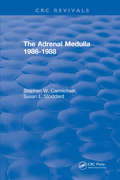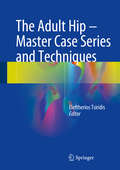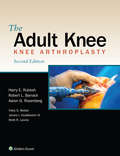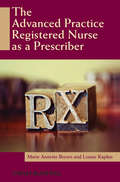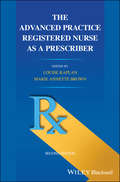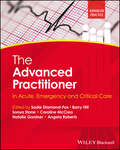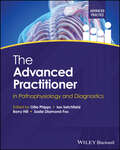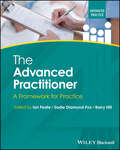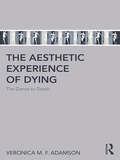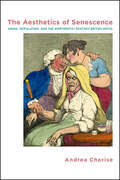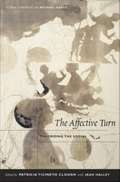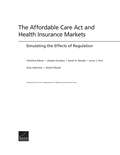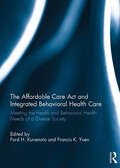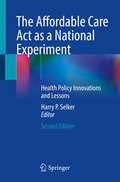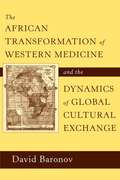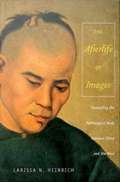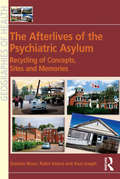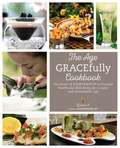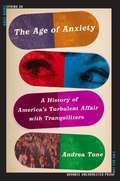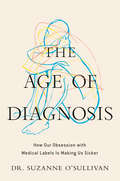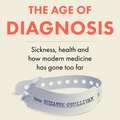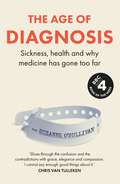- Table View
- List View
The Adolescent Athlete: A Practical Approach (Contemporary Pediatric and Adolescent Sports Medicine)
by Laura Purcell Lyle J. MicheliThis reader-friendly book takes a practical approach to caring for the adolescent athlete. Logically organized by joint, the book identifies both chronic and acute injuries in addition to congenital conditions. It details fundamentals, including basic anatomy, joint examination, and patient history. Emphasis is placed on the recognition of injury patterns unique to adolescent athletes and tables are incorporated throughout to assist with diagnosis. This book also highlights return to play guidelines and includes summary pearls. Anatomical photos, x-rays, and MRI scans illustrate all key concepts.
The Adrenal Medulla 1986-1988 (CRC Press Revivals)
by Stephen W. CarmichaelThis volume provides a complete review of all the articles which have appeared in the literature since 1986 that pertain to the adrenal medulla and adrenal chromaffin. Over 1700 articles are reviewed, organized, and summarized. Topics covered include the transplantation of medulla into the brain, stimulus-secretion coupling, neuropeptides, enzymes of catecholamine biosynthesis, growth factors, neural regulation and clinical considerations, including imaging and tumors. This book will provide interesting reading for neurobiologists, cell biologists, pathologists, diagnostic radiologists, and advanced biology students.
The Adult Hip - Master Case Series and Techniques
by Eleftherios TsiridisThis book is intended to offer a “virtual fellowship” in hip surgery that will give readers the opportunity to join distinguished hip surgeons in the operating room, learning key points and solutions to technical difficulties from the beginning to the end of 100 surgical cases. All of these cases have been carefully selected by renowned orthopaedists who work at the world’s top centers and perform surgery based on evidence. To facilitate quick learning, the cases are presented using a uniform template, guiding the reader from clinical evaluation and preoperative planning, through the decision-making process, to the surgical procedure and the final outcome. At the end of each case, the editor invites the surgeon to answer specific questions in order to further elucidate crucial issues with reference to current evidence. The book is divided into four sections: conservative hip surgery, primary hip arthroplasty, complex hip arthroplasty, and revision arthroplasty. It will be of value across the world to specialist hip surgeons and surgeons in training who are interested in hip surgery.
The Adult Knee
by Harry E. RubashAs knee replacement surgeries continue to grow in number worldwide, the need for an authoritative and comprehensive reference in this key area is a must for today’s orthopaedic surgeon. The Adult Knee: Knee Arthroplasty, Second Edition, brings together the knowledge and expertise of internationally recognized experts in the field in one convenient volume.
The Advanced Practice Registered Nurse as a Prescriber
by Louise Kaplan Marie Annette BrownA new era of opportunity is emerging for advanced practice registered nurses (APRNs) to increasingly address gaps in access to quality healthcare. APRNs must be prepared to practice to the full scope of their education and abilities. As more and more states pass legislation enhancing prescriptive authority and fully autonomous practice for APRNs, a comprehensive resource on prescribing practices is needed.The increasing demands of today's fast-paced healthcare environment require a new level of prescriber expertise. Knowledge about medication characteristics and effectiveness must be accompanied by an understanding of the context and process of prescribing. The Advanced Practice Registered Nurse as a Prescriber provides practicing APRNs and students with the information necessary to make fully informed, rational and ethical decisions as prescribers.This book opens with an overview of the role of the APRN prescriber and moves on to discussing practical issues such as managing difficult patient situations, special considerations when prescribing controlled substances, the influence of pharmaceutical marketing, state regulation, and legal aspects of prescribing. The book also examines barriers to prescribing, and the concluding chapter underscores key information to build cultural competence when prescribing.An evidence-based resource for all APRNs and APRN students, The Advanced Practice Registered Nurse as a Prescriber provides a comprehensive and practical resource essential for APRNs in all advanced practice roles.
The Advanced Practice Registered Nurse as a Prescriber
by Louise Kaplan Marie Annette BrownThe Advanced Practice Registered Nurse as a Prescriber is an authoritative reference guide designed for students and practicing APRNs alike—delivering the evidence-based information required for informed and ethical prescribing of medication in various clinical settings. Now in its second edition, this comprehensive book offers up-to-date coverage of all critical aspects of the prescriber role, including legal and regulatory responsibilities, managing difficult patient situations, assessing and addressing special considerations with controlled substances, and more. Drawing upon their clinical and professional experience, this respected team of authors provide clear and straightforward information based on current research and reliable evidence, helping readers identify and avoid common prescribing mistakes and pitfalls whilst presenting specific strategies to respond appropriately to an array of typical clinical experiences. This revised edition includes new and expanded chapters with information on authorizing medical marijuana, prescription monitoring programs, electronic prescribing, pharmacogenetics in prescribing and patient response, and issues surrounding controlled substance prescribing and prescribing for opioid use disorder. This leading single-volume resource: Addresses the opportunities, challenges and responsibilities that APRNs face as prescribers Covers the laws, regulations, and professional issues that affect prescribing Discusses global approaches to registered nurse and APRN prescribing such as task sharing, formularies, and independent authority Guides APRNs through difficult clinical situations such as patients seeking controlled substances and requesting inappropriate care Navigates the multiple facets of prescribing controlled substances Examines the role of the APRN in states with medical marijuana laws Serves as a resource to engage in advocacy for fully autonomous prescribing The Advanced Practice Registered Nurse as a Prescriber is essential reading for APRN and pharmacotherapeutics students, registered nurses transitioning to the role of APRN prescriber, and all APRNs including Nurse Practitioners (NP), Clinical Nurse Specialists (CNS), and Certified Registered Nurse Anesthetists (CRNA).
The Advanced Practitioner in Acute, Emergency and Critical Care (Advanced Clinical Practice)
by Ian PeateThe Advanced Practitioner in Acute, Emergency and Critical Care Dedicated text for trainee and newly-qualified Advanced Practitioners specialising in acute, emergency and critical care Aligned with the Nursing and Midwifery Council (NMC) and the Health and Care Professions Council (HCPC) regulatory body requirements, this formative text is the first of its kind, covering a variety of key topics for advanced practitioners working in acute, emergency and critical care. Written by experienced advanced practitioners and academics closely involved in the delivery of both the clinical and academic components of advanced practice training programmes, The Advanced Practitioner in Acute, Emergency and Critical Care presents: Complex decision making, covering legal and ethical frameworks (including patient safety), communication skills and breaking bad news, and end of life care Diagnosis and management of patients, covering radiology, principles of point of care ultrasound (PoCUS), laboratory tests and prescribing Resuscitation and first stage management of the critically unwell, advanced resuscitation skills, shock, intra- and inter-hospital transfers, and organ donation History taking, physical examination, and consultation models Learning support with accreditation considerations boxes, clinical investigations, examination scenarios, pharmacology boxes, pathological and psychological considerations, social and cultural considerations, case studies, self-assessment questions, and more Utilising a multi-professional and inclusive framework of advanced level practice, this is an essential resource for all trainee and newly-qualified advanced practitioners. The text also serves as an excellent classroom aid for lecturers teaching advanced practice courses.
The Advanced Practitioner in Pathophysiology and Diagnostics (Advanced Clinical Practice)
by Ian PeateAn experienced and multi-disciplinary team of authors map out the intricate interplay between pathophysiology and diagnostic decision-making, two pivotal cornerstones of advanced practice in healthcare The Advanced Practitioner in Pathophysiology and Diagnostics serves as an indispensable resource for practitioners seeking to deepen their understanding and refine their skills, as the mastery of these fundamental concepts becomes ever more crucial in an evolving healthcare landscape. This authoritative and comprehensive guide provides readers with an evidence-based, person-centred approach to the study of the functional changes that occur within the body due to disease or injury. With this knowledge, advanced practitioners must then build their diagnostic and treatment strategies, synthesising patient history, physical examination, and diagnostic tests. This text supports the advanced practitioner in developing a deeper understanding of both the mechanisms that drive disease and the critical thinking behind the diagnostic process. The Advanced Practitioner in Pathophysiology and Diagnostics readers will also find: Practical guidance on diagnostic strategies, emphasising the importance of evidence-based practice and differential diagnosisA multi-disciplinary approach suitable for a range of clinical backgroundsDetailed discussion of topics including pathophysiological processes, providing a robust foundation for clinical decision-making The Advanced Practitioner in Pathophysiology and Diagnostics is ideal for healthcare professionals interested in or undertaking advanced level practice, as well as for students completing the pathophysiology module on their MSc in advanced practice.
The Advanced Practitioner: A Framework for Practice (Advanced Clinical Practice)
by Ian Peate Barry Hill Sadie Diamond-FoxThe Advanced Practitioner An essential text for Advanced Practitioners In The Advanced Practitioner: A Framework for Practice, a team of distinguished Advanced Practitioners (APs) and academics deliver the go-to text for trainee APs, with a strong focus on the four pillars that underpin advanced practice: clinical practice, education, research, and leadership. The patient is at the core of this essential resource, which offers the knowledge required to care safely for people in a variety of care settings, as well as with a range of common and specialised holistic interventions. Readers will also find: A thorough introduction to the core principles of advanced practice, including the AP curriculum and the principles of physiology, pharmacology, and pathophysiology Comprehensive exploration of the clinical pillar, including discussions of clinical history taking and physical examination Practical discussion of the education and research pillars, including an exploration of research principles and education and learning Discussion of innovation in practice, the leadership pillar, and how to deal with difficult situations Perfect for trainee advanced practitioners, The Advanced Practitioner: A Framework for Practice will also benefit healthcare students and trainee medical associate professionals.
The Aesthetic Experience of Dying: The Dance to Death
by Veronica M. AdamsonStructured around a personal account of the illness and death of the author’s partner, Jane, this book explores how something hard to bear became a threshold to a world of insight and discovery. Drawing on German Idealism and Jane’s own research in the area, The Aesthetic Experience of Dying looks at the notion of life as a binary synthesis, or a return enhanced, as a way of coming to understand death. Binary synthesis describes the interplay between dynamically opposing pairs of concepts – such as life and death – resulting in an enhanced version of one of them to move forward in a new cycle of the process. Yet what relevance does this elegant word game have to the shocking diagnosis of serious illness? Struggling to balance reason with sense, thought with feeling, this book examines the experience of caring for someone from diagnosis to death and is illustrated with examples of the return enhanced. The concluding chapter outlines how the tension of Jane’s dying has been resolved as the rhythmic patterns of the lifeworld have been understood through the process of reflecting on the experience. This creative and insightful book will appeal to those interested in the medical humanities. It will also be an important reference for practising and student health professionals.
The Aesthetics of Senescence: Aging, Population, and the Nineteenth-Century British Novel (SUNY series, Studies in the Long Nineteenth Century)
by Andrea ChariseInvestigates how nineteenth-century British literature grappled with a new understanding of aging as both an individual and collective experience.Shortlisted for the 2020 BSLS Book Prize presented by the British Society for Literature and Science The Aesthetics of Senescence investigates how chronological age has come to possess far-reaching ideological, ethical, and aesthetic implications, both in the past and present. Andrea Charise argues that authors of the nineteenth century used the imaginative resources of literature to engage with an unprecedented climate of crisis associated with growing old. Marshalling a great variety of canonical authors including William Godwin, Mary Shelley, George Eliot, Anthony Trollope, and George Gissing, as well as less familiar writings by George Henry Lewes, Christoph Wilhelm Hufeland, Agnes Strickland, and Max Nordau, Charise demonstrates why the imaginative capacity of writing became an interdisciplinary crucible for testing what it meant to grow old at a time of profound cultural upheaval. Charise's grounding in medicine, political history, literature, and genre offers a fresh, original, thoroughly interdisciplinary analysis of nineteenth-century aging and age theory, as well as new insights into the rise of the novel-a genre usually thought of as affiliated almost entirely with the young or middle-aged.
The Affective Turn: Theorizing the Social
by Patricia Ticineto Clough Jean Halley"The innovative essays in this volume . . . demonstrat[e] the potential of the perspective of the affects in a wide range of fields and with a variety of methodological approaches. Some of the essays . . . use fieldwork to investigate the functions of affects--among organized sex workers, health care workers, and in the modeling industry. Others employ the discourses of microbiology, thermodynamics, information sciences, and cinema studies to rethink the body and the affects in terms of technology. Still others explore the affects of trauma in the context of immigration and war. And throughout all the essays run serious theoretical reflections on the powers of the affects and the political possibilities they pose for research and practice. "--Michael Hardt, from the foreword In the mid-1990s, scholars turned their attention toward the ways that ongoing political, economic, and cultural transformations were changing the realm of the social, specifically that aspect of it described by the notion of affect: pre-individual bodily forces, linked to autonomic responses, which augment or diminish a body's capacity to act or engage with others. This "affective turn" and the new configurations of bodies, technology, and matter that it reveals, is the subject of this collection of essays. Scholars based in sociology, cultural studies, science studies, and women's studies illuminate the movement in thought from a psychoanalytically informed criticism of subject identity, representation, and trauma to an engagement with information and affect; from a privileging of the organic body to an exploration of nonorganic life; and from the presumption of equilibrium-seeking closed systems to an engagement with the complexity of open systems under far-from-equilibrium conditions. Taken together, these essays suggest that attending to the affective turn is necessary to theorizing the social. Contributors. Jamie "Skye" Bianco, Grace M. Cho, Patricia Ticineto Clough, Melissa Ditmore, Ariel Ducey, Deborah Gambs, Karen Wendy Gilbert, Greg Goldberg, Jean Halley, Hosu Kim, David Staples, Craig Willse , Elizabeth Wissinger , Jonathan R. Wynn
The Affordable Care Act and Health Insurance Markets: Simulating the Effects of Regulation
by Christine Eibner Carter C. Price Amado Cordova Sarah A. Nowak Evan Saltzman Dulani WoodsIn this report, the authors estimate the effects of the Affordable Care Act on health insurance enrollment and premiums for ten states (Florida, Kansas, Louisiana, Minnesota, New Mexico, North Dakota, Ohio, Pennsylvania, South Carolina, and Texas) and for the nation overall, with a focus on outcomes in the nongroup and small group markets.
The Affordable Care Act and Integrated Behavioural Health Care: Meeting the Health and Behavioral Health Needs of a Diverse Society
by Ford H. Kuramoto and Francis K. YuenThis book provides a scholarly discussion of arguably the most important advance in U.S. public health services since Medicare 50 years ago - how the Federal program known as the Patient Care and Affordable Care Act of 2010 (ACA) or "Obamacare" became law. It addresses ACA in terms of its impact on improving health and behavioural health services for key diverse populations in America, including people with disabilities, consumers, women, racial and ethnic minorities, and veterans and their families.From the very beginning, ACA was controversial and the topic of heated political debate at both state and national levels. This book examines more closely how the legislation was developed, including the political history of the act; the many advocacy efforts at the national level and the community-based action strategies at the grassroots level; how ACA will affect a broad cross-section of America; the integration of health and behavioural health services as a key component of ACA; the financing of ACA and parity for behavioural health services.This book was originally published as a special issue of the Journal of Social Work in Disability & Rehabilitation.
The Affordable Care Act as a National Experiment: Health Policy Innovations and Lessons
by Harry P. SelkerThe landmark 2010 Patient Protection and Affordable Care Act (ACA), or “Obamacare,” is a topic of great debate in mainstream, academic, and scientific media that generated strong opinions across the political spectrum and our nation. Soon after the enactment of the ACA and the fierce debate that ensued, The Affordable Care Act as a National Experiment was published by Springer in 2014. Now five years later, just finishing an election year in which the ACA was a hotly debated issue, the second edition of this title examines the history, lessons, and impact of this ground-breaking legislation. Now a decade since implementation nationally, the ACA is the largest healthcare policy innovation in the United States in at least 50 years and one of our nation’s largest healthcare experiments ever. The history of public health and medicine shows us that to develop better solutions for important health problems, we must innovate. And when we try a new strategy, we are reminded that to innovate is to experiment. This is the basis of all medical research, public health interventions, and health policy innovations. Moreover, in recent years, there is an increasing emphasis on “translational science,” research that always has an ultimate focus on having real impact on medical care and the public’s health – whether in translating from bench research to the bedside, or from limited clinical use into widespread practice, public health interventions or policy.As with the previous edition, the book opens with a chapter that gives a basic overview of The Affordable Care Act. The second chapter, which previously discussed the objectives of the ACA, now takes a look at the successes, unfinished work and impact of the ACA in the past ten years. The third chapter now ponders the question of whether the ACA has protected patients since its implementation while its previous counterpart gave predictions for the future. The chapters that follow highlight things such as Medicaid expansion and insurance reform under the ACA, the Supreme Court Review of the ACA, social determinants of health, stories of the uninsured and stabilization of the ACA, among others. The book rounds out with a summary of what’s next and the push for universal healthcare followed by an epilogue. Due to the timely nature of the subject matter, some chapters from the previous edition have been dropped and seven new chapters have been added in their place. The remaining seven chapters from the previous edition have also been fully revised and updated. Written by nationally known healthcare policy leaders who were involved directly in the creation and implementation of the ACA, the second edition of The Affordable Care Act as a National Experiment again will examine the history and impact of this ground-breaking legislation as well as recommend priorities, objectives, and next steps for translational research. It is an essential resource for all healthcare providers as well as policy makers and academics.
The Affordable Care Act: A National Experiment
by June Wasser Harry SelkerThis book examines the landmark 2010 Patient Protection and Affordable Care Act (ACA) from the perspective of health policy research as translational science. It delineates a new perspective about the creation and potential impact of the ACA and guides the development of health policy that is supported by best evidence that, in turn, transforms into practice, policy, and public benefit. Told by those involved in the creation and implementation of the ACA, the book reviews the history and impact of this ground-breaking legislation and recommends priorities, objectives, and next steps for translational research as the ACA is implemented. The book includes coverage of these topics: · Objectives of the ACA · Analysis of data collected from healthcare reform programs in Vermont and Massachusetts to inform national implementation of the ACA · Engaging the public in, and building support for, ACA implementation · Interplay of federal, state, and local healthcare policy decisions arising from the enforcement of the ACA Featuring contributions from nationally renowned leaders in healthcare policy, this book adds to the public conversation about the ACA and its role in shaping health policy and contributes to a more realistic, nuanced, and productive understanding of this landmark legislation by physicians, policy makers, and the public. It also provides a framework for next steps in continuing to improve U.S. health policy.
The African Transformation of Western Medicine and the Dynamics of Global Cultural Exchange
by David BaronovBeginning with the colonial era, Western biomedicine has radically transformed African medical beliefs and practices. Conversely, in using Western biomedicine, Africans have also transformed it. The African Transformation of Western Medicine and the Dynamics of Global Cultural Exchange contends that contemporary African medical systems—no less “biomedical” than Western medicine—in fact greatly enrich and expand the notion of biomedicine, reframing it as a global cultural form deployed across global networks of cultural exchange. The book analyzes biomedicine as a complex and dynamic sociocultural form, the conceptual premises of which make it necessarily subject to ongoing change and development as it travels the globe. David Baronov captures the complexities of this cultural exchange by using world-systems analysis in a way that places global cultural processes on equal footing with political and economic processes. In doing so, he both allows the story of Africa’s transformation of “Western” biomedicine to be told and offers new insights into the capitalist world system.
The Afterlife of Images: Translating the Pathological Body Between China and the West
by Larissa N. HeinrichIn 1739 China's emperor authorized the publication of a medical text that included images of children with smallpox to aid in the diagnosis and treatment of the disease. Those images made their way to Europe, where they were interpreted as indicative of the ill health and medical backwardness of the Chinese. In the mid-nineteenth century, the celebrated Cantonese painter Lam Qua collaborated with the American medical missionary Peter Parker in the creation of portraits of Chinese patients with disfiguring pathologies, rendered both before and after surgery. Europeans saw those portraits as evidence of Western medical prowess. Within China, the visual idiom that the paintings established influenced the development of medical photography. In The Afterlife of Images, Ari Larissa Heinrich investigates the creation and circulation of Western medical discourses that linked ideas about disease to Chinese identity beginning in the eighteenth century. Combining literary studies, the history of science, and visual culture studies, Heinrich analyzes the rhetoric and iconography through which medical missionaries transmitted to the West an image of China as "sick" or "diseased. " He also examines the absorption of that image back into China through missionary activity, through the earliest translations of Western medical texts into Chinese, and even through the literature of Chinese nationalism. Heinrich argues that over time "scientific" Western representations of the Chinese body and culture accumulated a host of secondary meanings, taking on an afterlife with lasting consequences for conceptions of Chinese identity in China and beyond its borders.
The Afterlives of the Psychiatric Asylum: Recycling Concepts, Sites and Memories (Geographies of Health Series)
by Graham Moon Robin KearnsThe last 40 years has seen a significant shift from state commitment to asylum-based mental health care to a mixed economy of care in a variety of locations. In the wake of this deinstitutionalisation, attention to date has focussed on users and providers of care. The consequences for the idea and fabric of the psychiatric asylum have remained 'stones unturned'. This book address an enduring yet under-examined question: what has become of the asylum? Focussing on the 'recycling' of both the idea of the psychiatric asylum and its sites, buildings and landscapes, this book makes theoretical connections to current trends in mental health care and to ideas in cultural/urban geography. The process of closing asylums and how asylums have survived in specific contexts and markets is assessed and consideration given to the enduring attraction of asylum and its repackaging as well as to retained mental health uses on former asylum sites, new uses on former sites, and interpretations of the derelict psychiatric asylum. The key questions examined are the challenges posed in seeking new uses for former asylums, the extent to which re-use can transcend stigma yet sustain memory and how location is critical in shaping the future of asylum and asylum sites.
The Age GRACEfully Cookbook: The Power of FOODTRIENTS To Promote Health and Well-being for a Joyful and Sustainable Life
by Grace OFoodTrients, originated by Grace O, is a unique program supported by current research that positions food as an anti-aging strategy for achieving sustainable health. A FoodTrient is her name for the natural anti-aging properties of food. Delicious foods and rejuvenating nutrients combine to create Aging GRACEfully Cookbook, a collection of enticing and nourishing recipes that promote health and well-being for a joyful and sustainable life. The recipes are built on the foundations of modern scientific research and ancient knowledge of medicinal herbs and natural ingredients from cultures all around the world. There are many books about super foods and supplements, but few provide at-a-glance guides in each recipe detailing key ingredients and how they increase health and longevity. Grace O’s cookbook focuses on five categories of FoodTrient that are essential to healthful living: Antioxidant: Prevents and repairs oxidative damage to cells caused by free radicals Anti-inflammatory: Reduce inflammatory process in cells, tissues, and blood vessels, helping to slow aging and reduce risk of long-term disease Immunity Boosters: Support the body’s resistance to infection and strengthen immune vigilance and response Mind and Beauty: Enhancers that encourage vibrant skin and hair and improve mood and mental agility Disease-Preventing: Reduces risk factors for common degenerative and age-related diseases These sixty-six beautifully illustrated recipes incorporate all the ingredients you need to look and feel younger, not only on the inside but also on the outside.
The Age of Anxiety: A History of America's Turbulent Affair with Tranquilizers
by Andrea ToneAnxious Americans have increasingly pursued peace of mind through pills and prescriptions. In 2006, the National Institute of Mental Health estimated that 40 million adult Americans suffer from an anxiety disorder in any given year: more than double the number thought to have such a disorder in 2001. Anti-anxiety drugs are a billion-dollar business. Yet as recently as 1955, when the first tranquilizer-Miltown-went on the market, pharmaceutical executives worried that there wouldn't be interest in anxiety-relief. At mid-century, talk therapy remained the treatment of choice.But Miltown became a sensation-the first psychotropic blockbuster in United States history. By 1957, Americans had filled 36 million prescriptions. Patients seeking made-to-order tranquility emptied drugstores, forcing pharmacists to post signs reading "more Miltown tomorrow." The drug's financial success and cultural impact revolutionized perceptions of anxiety and its treatment, inspiring the development of other lifestyle drugs including Valium and Prozac.In The Age of Anxiety, Andrea Tone draws on a broad array of original sources-manufacturers' files, FDA reports, letters, government investigations, and interviews with inventors, physicians, patients, and activists-to provide the first comprehensive account of the rise of America's tranquilizer culture. She transports readers from the bomb shelters of the Cold War to the scientific optimism of the Baby Boomers, to the "just say no" Puritanism of the late 1970s and 1980s.A vibrant history of America's long and turbulent affair with tranquilizers, The Age of Anxiety casts new light on what it has meant to seek synthetic solutions to everyday angst.
The Age of Diagnosis: How Our Obsession with Medical Labels Is Making Us Sicker
by Suzanne O'SullivanFrom a neurologist and the award-winning author of The Sleeping Beauties, a meticulous and compassionate exploration of how our culture of medical diagnosis can harm, rather than help, patients.We live in an age of diagnosis. Conditions like ADHD and autism are on the rapid rise, while new categories like long Covid are being created. Medical terms are increasingly used to describe ordinary human experiences, and the advance of sophisticated genetic sequencing techniques means that even the healthiest of us may soon be screened for potential abnormalities. More people are labeled "sick" than ever before—but are these diagnoses improving their lives?With scientific authority and compassionate storytelling, neurologist Suzanne O'Sullivan argues that our obsession with diagnosis is harming more than helping. It is natural when we are suffering to want a clear label, understanding, and, of course, treatment. But our current approach to diagnosis too often pathologizes difference, increases our anxiety, and changes our experience of our bodies for the worse.Through the moving stories of real people, O'Sullivan compares the impact of a medical label to the pain of not knowing. She explains the way the boundaries of a diagnosis can blur over time. Most importantly, she calls for us to find new and better vocabularies for suffering and to find ways to support people without medicalizing them.
The Age of Diagnosis: Sickness, Health and Why Medicine Has Gone Too Far
by Suzanne O’Sullivan'Slices through the confusion with grace and compassion. I cannot say good enough things about it.' - CHRIS VAN TULLEKEN'A brilliant study of the dangers of overdiagnosis' - GUARDIAN, book of the day'Be prepared for compassionate and bracingly independent thinking' - THE TIMES, best books of 2025From autism to allergies, ADHD to long Covid, more people are being labelled with medical conditions than ever before. But can a diagnosis do us more harm than good? The boundaries between sickness and health are being redrawn. Mental health categories are shifting and expanding all the time, radically altering what we consider to be 'normal'. Genetic tests can now detect pathologies decades before people experience symptoms, and sometimes before they're even born. And increased health screening draws more and more people into believing they are unwell. An accurate diagnosis can bring greater understanding and of course improved treatment. But many diagnoses aren't as definitive as we think. And in some cases they risk turning healthy people into patients. Drawing on the stories of real people, as well as decades of clinical practice and the latest medical research, Dr Suzanne O'Sullivan overturns long held assumptions and reframes how we think about illness and health.
The Age of Diagnosis: Sickness, Health and Why Medicine Has Gone Too Far
by Suzanne O’Sullivan'Covers so many topics that have been troubling me but I haven't been able to resolve myself - as a parent and a clinician. An absolutely absorbing read from start to finish.' - CHRIS VAN TULLEKEN'A brilliant study of the dangers of overdiagnosis' - GUARDIAN, book of the day'Compassionate and bracingly independent thinking' - THE TIMES, best books of 2025From autism to allergies, ADHD to long Covid, more people are being labelled with medical conditions than ever before. But can a diagnosis do us more harm than good? The boundaries between sickness and health are being redrawn. Mental health categories are shifting and expanding all the time, radically altering what we consider to be 'normal'. Genetic tests can now detect pathologies decades before people experience symptoms, and sometimes before they're even born. And increased health screening draws more and more people into believing they are unwell. An accurate diagnosis can bring greater understanding and of course improved treatment. But many diagnoses aren't as definitive as we think. And in some cases they risk turning healthy people into patients. Drawing on the stories of real people, as well as decades of clinical practice and the latest medical research, Dr Suzanne O'Sullivan overturns long held assumptions and reframes how we think about illness and health.
The Age of Fentanyl: Ending the Opioid Epidemic
by Brodie RaminIs there a way to end North America’s opioid epidemic? In The Age of Fentanyl, Brodie Ramin tells the story of the opioid crisis, showing us the disease and cure from his perspective as an addiction doctor working on the front lines. We meet his patients, hear from other addiction experts, and learn about the science and medicine of opioid addiction and its treatments. He shows us how addiction can be prevented, how knowledge can reduce stigma, and how epidemics can be beaten. Dr. Ramin brings the hopeful message that just as patients and health care workers rallied together to fight HIV one generation ago, a coalition of patients, advocates, scientists, doctors, and nurses is once again finding solutions and making plans to stem the overdose deaths, block the spread of fentanyl, and end the epidemic.

